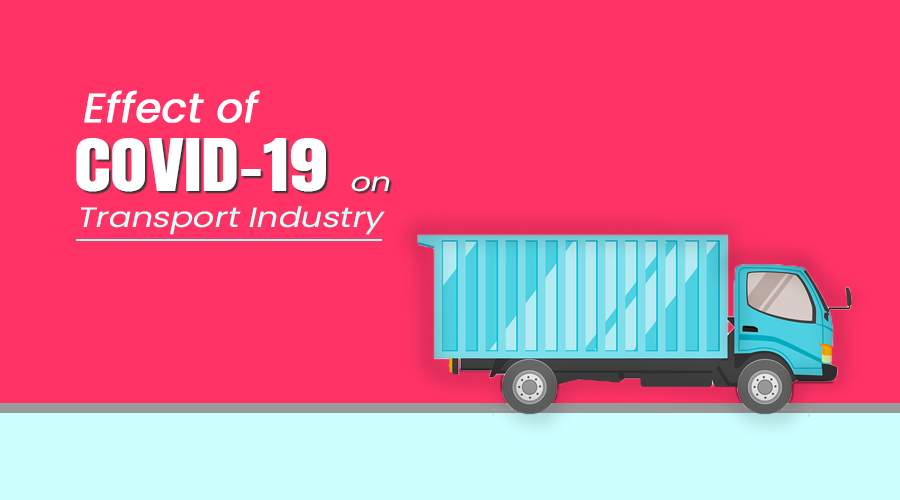One of the major sectors that boost our country’s economy is transportation and due to of the COVID-19 pandemic; it has been severely affected by its impact.
The transport sector contributes up to 4.8% of the India’s Gross Value Addition. The percentage can be broken down as follows- Road Transport 3.1% | Railways 0.8% | Air 0.2% | and water transport 0.1%.
COVID, short for China originated virus in December 19, was initially found infecting a student who had returned from Wuhan, China on 30th January 2020 in India in the southern state of Kerala.
Since then, COVID-19 has spread to all states of India and the total (cumulative) number of confirmed infected people is around 31.3 million as of 24th July 2021 across the country.
The pandemic is a demand-cum-supply shock hence it resulted in a significant reduction in travel and commercial activity.
Drastic effects of COVID -19 have been felt across the transport sector. Many transport organisations had to experience a sudden shortfall in their finances.
The transport sector is forced to change its focus from moving citizens to establishing a robust transportation system with a skeletal workforce to make sure important freight and essential workers can continue to move.
The current need of the hour is to understand the maximum duration of how long will the transport industries affected. Will this pandemic change the travel behavior of commuters? And what should we hope in the future?
Also Read: Use of FASTag in Transport
IMPACT OF COVID ON TRANSPORT SECTOR
Railway Transport- Movement of passengers and cargo during COVID-19 lockdown in India.
- Daily freight flow was 3 million tonnes prior to lockdown but during lockdown, it has shrunken to 2 million tonnes.
- Daily passenger non-suburban (intercity) special migrant rail ridership was 10 million passengers prior to lockdown and 0.17 million during lockdown.
- The no. of people moving via Public Road Transport using Buses (per day) was 70 million prior to lockdown and 4 million during lockdown.
- Number of accidents per day prior to lockdown were 1280 but during lockdown, it fell to 47.
- Average pre-covid-19 daily domestic-cum-international passengers were 550,000 prior to lockdown and 200,000 during lockdown.
WHAT THE EXPERTS SAY
Experts believe that the immediate future will show signs of reduced travel demand for public transport. They suggest pandemic has created a low preference towards public transport due to fear of safety and lack of standard practices and infrastructure to effectively maintain social distances.
This recent change in behaviour will induce a reduction in the number of services available and in turn a hike in fares.
The increased ‘Work from Home’ culture has too significantly reduced travel demand. Though people will gradually shift back to public transport, but only when the trust is restored, this may take a little longer time.
Largely the travel behaviour of the people has also changed significantly with respect to both demand and the means of commute.
According to a survey conducted by CPPR (Centre for Public Policy Research), large number of respondents chose private transportation over public transportation post-lockdown.
Most of the experts also believe that there would be a huge shrinkage in travel demand that will be triggered by changes like reduced job opportunities and work from home culture.
The impact of COVID-19 on transport industry has led people to be concerned about safety measures, and hence people have started an amplified preference for private vehicles, non-motorised transport (NMT) and shared mobility facilities with shrunken dependency on public transport.
It is predicted unanimously by experts that there will be a shift in the share of key modes of transport with two-wheelers increasing its share significantly and on the other hand, that of Metro services reducing significantly.
Transport which is non-motorized like Cycling and Walking would also be increasingly chosen. Public motorized transport such Buses and Auto-rickshaws will have to struggle for a share of the pie and will have to drive themselves by increased fares/ pricing.
Experts also feel that this shift might persist for a short term and that the industry would be normalized to pre-Covid patterns once the virus is tamed.
Coping mechanism to tackle COVID-19 by Transport authorities.
Every state has implemented different coping mechanisms to tackle COVID-19. Ministry of Home Affairs has issued various guidelines which include standard operating protocols such as physical distancing and mandatory wearing of masks.
In the capital city of India – Delhi, they had laid out various guidelines for movement of people in transport in official and commercial complexes with mandatory physical distancing. They had also curtailed transit services and halted all its metro services.
Talking about the case of Delhi metro which spans across a total length of 387 Kms, got reopened on 9th September 2020 during then ongoing unlock 9.0.
The passengers count was around 100,000 per day which was significantly lower than 480,000 per day level peak ridership prior to the COVID-19 lockdown.
This drastic change was due to both the physical distancing protocols limiting the number of passengers per train and the fear in the minds of commuters which was still embedded in about using the using the public transport.
Despite undertaking all the best safety norms including frequent sanitization of the trains, concourse area, etc the perceptions of safety with regard to public transport especially metro have been on the negative side during the COVID-19 times.
Also Read: How to Create Transport Bilty Online For Free
Potential long term impact on transport industry
Transport sector will have to ensure that their networks can continue to operate throughout every lockdown measure. The sector would need to strike a fine balance b/w restricted operations and offering sufficient capacity for workers to be able to practice social distancing.
All long term investment plans would need to be reconsidered keeping in view the reduced revenues. The sector would need to ensure that its staff with essential skills are available in such situations to keep functions operating consistently.
It would take a significant amount of time in bringing back commuting and travelling patterns to pre-COVID levels.
Conclusion
Now that the lockdown is easing down, we can see some more shifts in transport sector that would change the scenario of the foreseeable future.
Having issues in creating, managing and sharing bilty/LR/Loading Invoice? Roadwe- an online transport bilty maker, LR and Loading invoice maker is an app through which transporters can build beautiful and professional looking transport Bilty, Loading Invoice, LR in seconds and share with anyone from your phone or desktop.
Download the app from Play Store.


